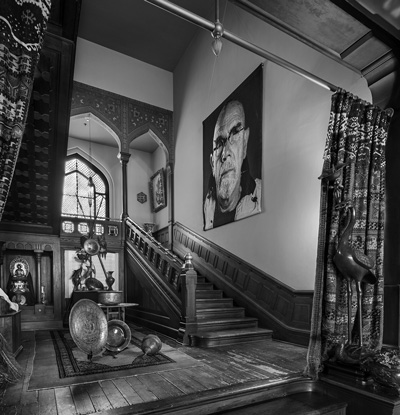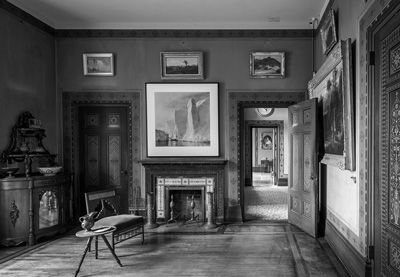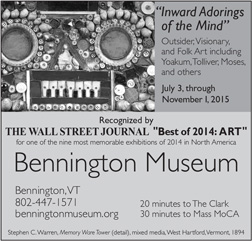Arts & Culture September 2015
Hudson River artistry, past and present
Show sets contemporary works at historic homes of Cole, Church
 By JOHN TOWNES
By JOHN TOWNES
Contributing writer
HUDSON, N.Y.
Chuck Close’s self-portrait adds a touch of the surreal to Olana, the historic home of the Hudson River School painter Frederic Edwin Church. Peter Aaron photo/courtesy Olana State Historic Site
Visitors to the historic homes of 19th century artists Frederic Edwin Church and Thomas Cole are entering an aesthetic time warp this season as a result of a major collaborative exhibit of contemporary artwork inspired by the painters.
The two homes are independent historic sites, one designated by the state and the other by the federal government, two miles apart on either side of the Hudson River. They are each dedicated to the faithful preservation of the two artists’ original homes and studios.
Olana State Historic Site, the former home and studio of Church, is a mansion at the summit of a 250-acre hilltop estate in Greenport, just south of the city of Hudson. And the Thomas Cole National Historic Site is a 2.5-acre property in the village of Catskill, just across the Rip Van Winkle Bridge.
The original period furniture, artwork and other details of each house have been preserved or recreated exactly as they were when the respective artists lived and worked there.
But for the new exhibit, called “River Crossings: Contemporary Art Comes Home,” the interiors of each home are being deliberately offset by artistic anachronisms.
For example, a doorway inside Olana is flanked by a traditional serious portrait of Frederic Church on one wall, while an adjacent wall features a whimsical painting by contemporary artist Will Cotton depicting a young woman with large, brightly-colored sweets on her head.
In a large formal dining room, dominated by an immense antique table and walls filled with old paintings, the portentous atmosphere is both intensified and disrupted by a sculptural installation by Valerie Hegarty that depicts a landscape painting and furniture in the process of being picked apart and punctured with large holes by woodpeckers.
Meanwhile, in Cole’s home, one of the rooms is filled with multimedia installations that include video art and projections of moving light. One of the traditional bedrooms is lined with an assemblage of miniature baseball caps created by Charles LeDray.
These and other paradoxes reflect the overall theme of the show, which is to compare and contrast the works and sensibilities of Cole and Church with their counterparts in the modern art world.
The show, which opened in May and continues through Nov. 1, also is intended to reflect the role of the Hudson River region as a focal point of creativity, then and now. It is the first major joint exhibit the two historic sites have held, and it’s the first major show in which either has prominently featured contemporary art.
“This groundbreaking exhibition puts these historic properties in an entirely new context,” said Betsy Jacks, director of the Thomas Cole National Historic Site. “In doing so, it creates a new understanding of how essential the work of Cole and Church has been to the contemporary art that we enjoy today.”
 Pioneers of American art
Pioneers of American art
Cole and Church were among the foremost practitioners of the mid-19th century movement in painting known as the Hudson River School, which emphasized depictions of nature and landscapes. It often featured sweeping vistas and dramatic skies to convey underlying emotional and spiritual themes.
Cole (1801-1848) is largely credited as the originator of the movement. Church (1826-1900) was one of Cole’s students and became one of the movement’s most popular proponents.
The Hudson River School drew its name from the fact that many of its prominent works depicted scenes in and around the Hudson Valley, although the artists associated with the movement also portrayed other scenes from the Northeast, the West and places as far away as South America.
Today, the paintings of the Hudson River School are considered traditional and even staid. But in their day, they were seen both as modern and groundbreaking, said Evelyn Trebilcock, the curator of Olana.
“Frederic Church and Thomas Cole were considered cutting-edge artists,” Trebilcock said. “The Hudson River School was the first major American art movement, and it was a break from the dominant European tradition. It captured the spirit of this nation and its natural wonders in a way that was distinctly different and new.”
She added that Cole’s and Church’s paintings also became very fashionable in the era before modern media.
“It was the popular culture of the day,” she said. “When their work was on public display, people would buy tickets to look at the paintings -- like we go out to the latest movie today.”
That role in popular culture, and its parallels with contemporary art, is what inspired the current River Crossings show.
“It’s a conversation between the past and present,” Trebilcock said. “The work also reflects questions and themes that have existed for artists of both eras, such as how to represent the landscape and nature.”
The Olana State Historic Site, which will celebrate its 50th anniversary next year, is owned and administered by the state Office of Parks, Recreation and Historic Preservation. Its programs and staff are managed by the Olana Partnership, a private, nonprofit educational corporation. In addition to the mansion, the property includes a carefully maintained landscape, originally designed by Church, including a former farm he operated there.
The Thomas Cole site, operated by an independent nonprofit organization, includes Cole’s house and a studio in an outbuilding on the property, which was known in Cole’s day as Cedar Grove.
Connecting two eras
The concept of juxtaposing contemporary art with the historic characteristics of the two sites was suggested by Stephen Hannock, a prominent artist who has a home in Berkshire County and is involved in preserving the Cole House.
Hannock is a widely recognized luminist painter whose style is influenced by the work of Cole and Church -- but in a contemporary form, with variations such as the inclusion of phrases in small text embedded within the landscapes.
“When he proposed this, we saw it as an opportunity to work together and encourage people to come to this area and visit both sites on the same trip,” Trebilcock said.
Hannock is co-curator of the show with Jason Rosenfeld, a professor and chairman of the art history department at Marymount Manhattan College in New York City.
Hannock and Rosenfeld conceived of River Crossings as an exploration of the history of art of the mid-19th century and its resonance today. They also aimed to connect the historic and contemporary roles of the Hudson River region as a center of creative activity.
They chose artists who have a direct connection to the region, or whose work relates to the themes of Cole and Church -- or those who have parallel roles in the contemporary art world.
The show contains a variety of styles and types of art, including painting, sculpture, photography and mixed media. In addition to the interior installations, some sculpture is also displayed on the grounds of the two properties.
After Hannock and Rosenfeld invited artists to participate in the show, they provided lists of possible works, and officials at each site then selected specific artworks they felt best suited their locations.
A total of 28 artists are represented, including Hannock, Cindy Sherman, Chuck Close, Romare Bearden, Elijah Burgher, Will Cotton, Gregory Crewdson, Lynn Davis, Jerry Gretzinger, Don Gummer, Duncan Hannah, Valerie Hegarty, Angie Keefer, Kara Hamilton, Kianja Strobert, Charles LeDray, Maya Lin, Frank Moore, Elizabeth Murray, Rashaad Newsome, Thomas Nozkowski, Stephen Petegorsky, Martin Puryear, Cindy Sherman, Sienna Shields, Kiki Smith, Joel Sternfeld, Letha Wilson and Elyn Zimmerman.
The staff at each of the historic sites made their own decisions about how to present the exhibit. In most instances, individual artworks at each property were temporarily replaced with contemporary counterparts. But the cumulative effect is somewhat different in each site, in part because of their distinct characteristics.
Olana is a much larger and more elaborate mansion, designed by Church as a hybrid of American and Persian architecture. The contemporary works at Olana are integrated subtly but noticeably among the many existing historic artworks and furnishings that fill its ornate interior.
For example, a massive self-portrait by Chuck Close temporarily occupies a space above a staircase where a more traditional tapestry usually hangs.
“We wanted to create a careful balance between the contemporary artwork and the rest of the house,” Trebilcock said.
While also substantial, the Cole house is more traditional architecturally and has a more modest scale. In that setting, the contemporary art is more visually dominant and is a primary feature in several hallways and rooms.
The exhibition is accompanied by hardcover companion book, also titled “River Crossings: Contemporary Art Comes Home.” It includes a foreword by historian Ken Burns on the Hudson Valley as an ongoing inspiration to artists, as well as essays on the exhibition by both curators and by cultural writers Maurice Berger and Marvin Heiferman.
Trebilcock said the exhibit has been a success and so far has stimulated attendance at the sites while generating interest from the art world and among the wider public. The two historic sites are considering the possibility of future collaborations, she added.
“It makes sense because, in many ways, Olana and the Thomas Cole house are part of the same story, and working together like this can benefit both sites and the region overall,” Trebilcock said.
Tours are included with the admission price at each site. Visit www.rivercrossings.org for more details.

